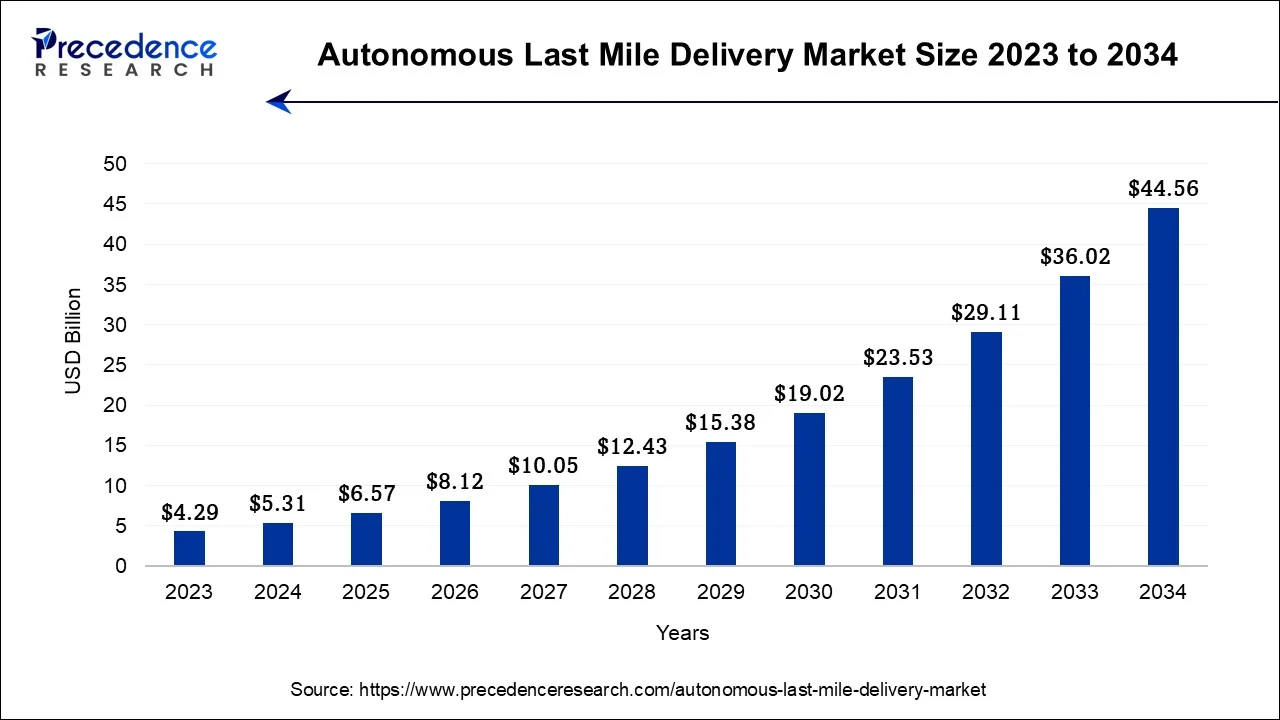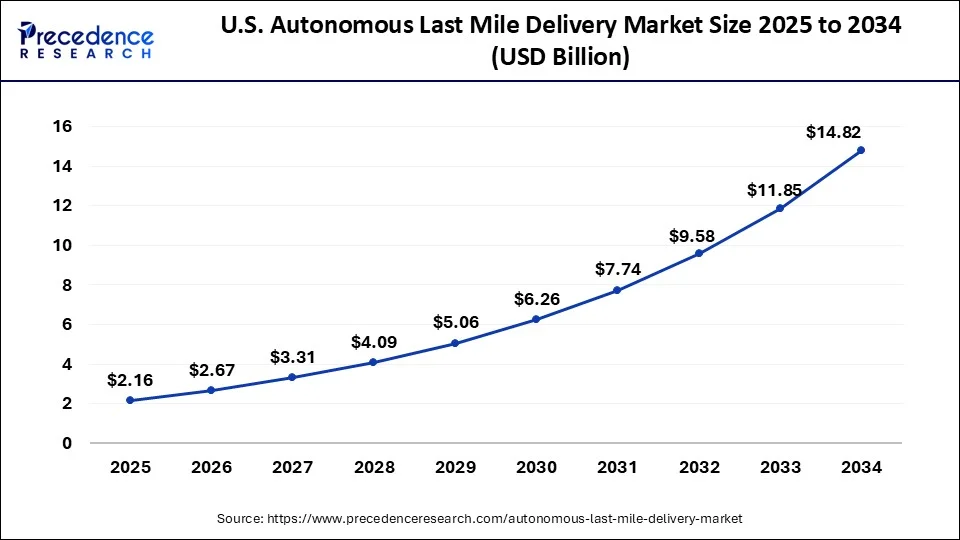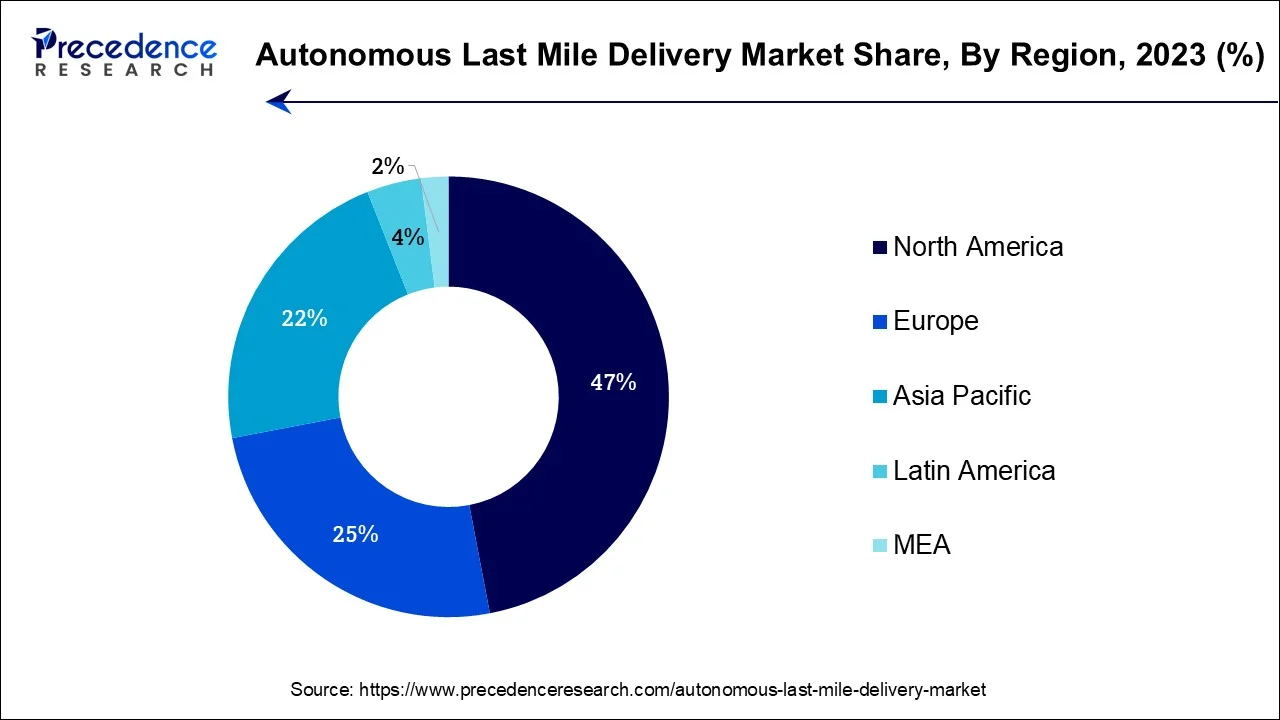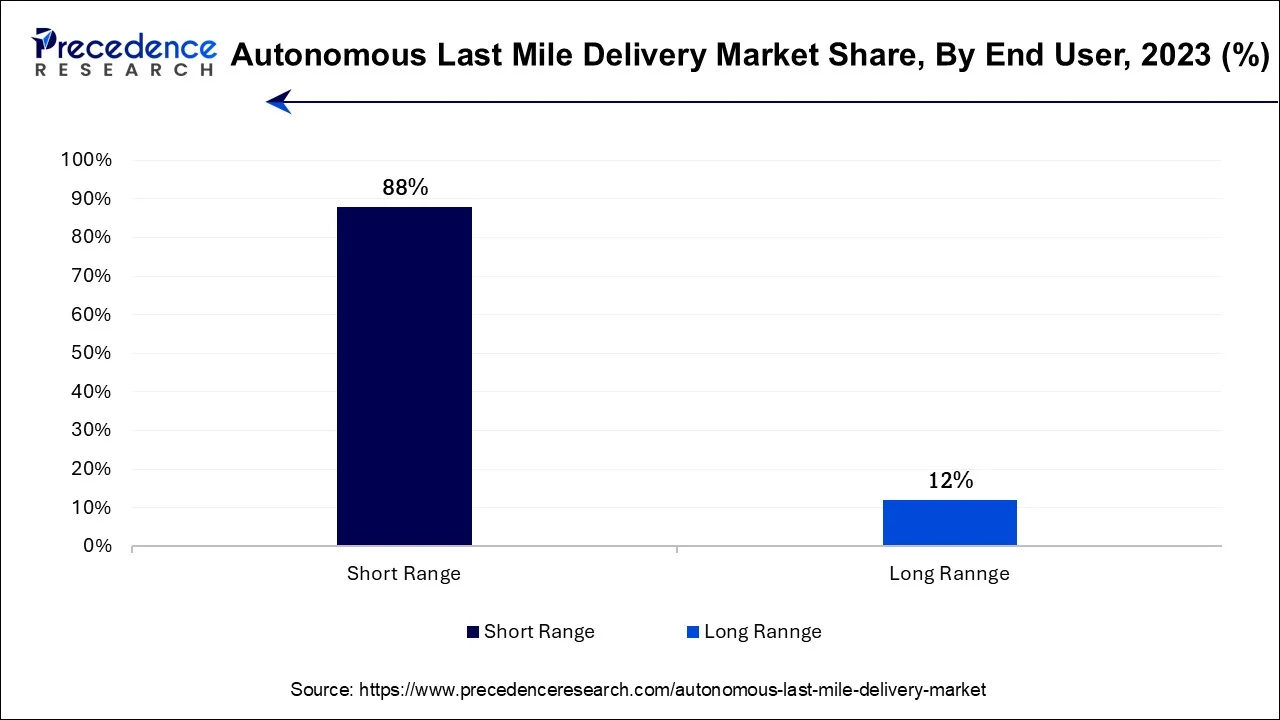List of Contents
Autonomous Last Mile Delivery Market Size and Forcast 2025 to 2034
The global autonomous last mile delivery market size accounted for USD 5.31 billion in 2024, and is anticipated to hit around USD 6.57 billion by 2025, and is anticipated to reach around USD 44.56 billion by 2034, expanding at a CAGR of 23.71% between 2025 and 2034.

Autonomous Last Mile Delivery Market Key Takeaways
- In terms of revenue, the market is valued at $6.57 billion in 2025.
- It is projected to reach $44.56 billion by 2034.
- The market is expected to grow at a CAGR of 23.70% from 2025 to 2034.
- North America has held the highest market share of 47% in 2024.
- By Platform, the ground delivery vehicles segment has captured the highest market share of 84% in 2024.
- By Range, the short-range (<20 kilometers) segment accounted highest market share of 88% in 2024.
- By End-use, the food & beverage segment has captured the highest revenue share of over 86% in 2024.
U.S Autonomous Last Mile Delivery Market Size and Growth 2025 to 2034
The global autonomous last mile delivery market size was estimated at USD 1.75 billion in 2024 and is predicted to be worth around USD 14.82 billion by 2034, growing at a CAGR of 23.81% from 2025 and 2034.

North America has held the largest revenue share in 2024. The North America autonomous delivery market is a rapidly evolving and dynamic sector in the field of autonomous logistics. Serving as a central hub, this innovative platform propels companies in both the United States and Canada towards autonomous delivery technologies. The market's remarkable growth can be attributed to various contributing factors that ensure its ongoing success. One of these is the flourishing e-commerce landscapes, which have provided immense opportunities for businesses. Additionally, significant technological advancements have played a crucial role in driving this growth forward. Lastly, there is an increasing demand for efficient last mile delivery solutions, further fueling the market's expansion. In the United States, industry giants like Amazon and Walmart are leading the way by investing in and testing various autonomous delivery technologies. These include drones, sidewalk robots, and self. These endeavors aim to improve delivery efficiency while cutting costs.
The North America Autonomous Delivery Market benefits from regulatory support and a collaborative ecosystem that fosters innovation. Forward-thinking regulations in several states and provinces facilitate the testing and deployment of autonomous vehicles and drones, creating an environment conducive to technology companies operating in this field.

The Asia-Pacific autonomous delivery market is experiencing rapid growth, with a significant impact expected on the future of autonomous last mile logistics. This region includes China, Japan, South Korea, India, and Australia, all known for their diverse landscapes that foster technological innovation. Within this dynamic setting lie unique challenges and opportunities for autonomous delivery systems. Several factors contribute to the success of the Asia-Pacific market: a thriving e-commerce industry, densely populated urban centers, supportive testing and deployment regulations, as well as a strong culture of technological advancement. As companies within this region continue to invest in and enhance their autonomous delivery solutions, the market is poised for remarkable growth. It promises to revolutionize last mile logistics practices while contributing to global advancements in autonomous delivery technology.
Market Overview
The autonomous last-mile delivery market marks a significant shift in the logistics and transportation industry. It involves employing advanced autonomous technologies, such as drones, self-driving vehicles, and robotic systems. Cutting-edge innovations now efficiently transport goods from distribution centers or hubs to their final destinations within the last leg of the supply chain. This dynamic market has gained significant momentum in response to the growing demand for faster, more cost-effective, and environmentally sustainable delivery solutions. The need is particularly evident in urban areas where congestion and delivery challenges prevail.
Autonomous last mile delivery systems have been developed to enhance the efficiency of deliveries, lower operational costs, and minimize instances of human error. These advanced technologies leverage artificial intelligence, machine learning, computer vision, and sensor fusion capabilities. By incorporating these advancements, these systems enable 24/7 delivery capabilities and ensure faster delivery times for enhanced consumer convenience.
The burgeoning e-commerce industry and the impact of the COVID-19 pandemic have expedited the adoption of autonomous last mile solutions. In response to this demand, retailers, logistics companies, and tech giants are making substantial investments in research and development to optimize and scale these innovative technologies.
Autonomous Last Mile Delivery Market Growth Factors
The rise of e-commerce has completely transformed consumer expectations. Nowadays, people demand faster, more efficient, and dependable delivery services like never before. Autonomous last mile solutions emerge as a promising way to meet these high expectations. They allow retailers and delivery companies to offer same day or even with-in-hour delivery options. Providing this level of convenience not only satisfies consumer demands but also fosters brand loyalty and enhances competitiveness in a crowded market. Furthermore, the cost-effectiveness of autonomous last mile solutions drives market growth. While the initial investment in technology and infrastructure may be significant, companies can benefit from long-term savings in labor costs, reduced fuel consumption, and fewer delivery errors. This makes cost-efficiency an appealing prospect for businesses seeking to streamline operations and enhance their financial performance.
Environmental considerations are crucial for the growth of this market. As climate change and sustainability become more prominent concerns, autonomous last mile delivery solutions are seen as a way to minimize emissions by optimizing routes, utilizing electric or hybrid vehicles, and establishing centralized charging or refueling stations. Incentives from governments and regulatory bodies further fuel the adoption of such environmentally friendly initiatives that embrace autonomous last mile technologies.
Market Scope
| Report Coverage | Details |
| Market Size by 2034 | USD 44.56 Billion |
| Market Size in 2025 | USD 6.57 Billion |
| Market Size in 2024 | USD 5.31 Billion |
| Growth Rate from 2025 to 2034 | CAGR of 23.70% |
| Largest Market | North America |
| Base Year | 2024 |
| Forecast Period | 2025 To 2034 |
| Segments Covered | Application, Solution, Range, Vehicle Type, and Region |
| Regions Covered | North America, Europe, Asia-Pacific, Latin America, and Middle East & Africa |
Market Dynamics
Drivers
Rise in delivery volumes
The demand for e-commerce and online shopping has skyrocketed as the global economy undergoes a digital transformation. This surge poses challenges for traditional delivery methods, with an exponential increase in goods requiring last mile delivery. In this context, autonomous last mile solutions emerge as a timely and scalable response to meet the growing demand.
The convenience of online shopping, particularly accelerated by the COVID-19 pandemic, has prompted businesses to seek faster and more efficient product delivery to satisfy consumer expectations. Autonomous vehicles, drones, and robotic systems offer 24/7 operation capabilities that reduce delivery times and increase capacity. During peak shopping seasons, such as holidays or promotional events, these systems prove especially valuable. They effectively handle delivery volumes that reach their highest point.
Moreover, autonomous last mile delivery systems offer a degree of scalability that empowers companies to adapt swiftly to changes in demand without facing an upsurge in labor expenses. By effortlessly adjusting the fleetsize of autonomous vehicles or drones according to delivery volumes, businesses can optimize resources and streamline operational costs. This level of flexibility becomes especially vital in urban areas where congestion and logistical obstacles arise from high population densities and limited road infrastructure.
Therefore, the growth of the autonomous last mile delivery market is being propelled by the increasing prevalence of e-commerce and the subsequent surge in delivery volumes. These advanced systems offer an adaptable and efficient solution to cater to the growing need for prompt, dependable, and cost-effective last mile delivery services. As delivery volumes continue to climb, autonomous technologies are anticipated to revolutionize logistics and delivery, enabling businesses to meet the ever-increasing expectations of digital-age consumers.
Restraint
Limited payload
The growth of the autonomous last mile delivery market is hampered by limited payload capacity. While technologies like drones and small robotic vehicles offer advantages in speed and accessibility, their ability to carry heavier or larger payloads is restricted. This limitation affects the effective delivery of certain products using autonomous systems, especially those that surpass weight or size limits. Industries handling bulkier or specialized cargo, such as furniture, appliances, or industrial equipment, might find it impractical to use these autonomous solutions.
Furthermore, businesses requiring multiple items to be transported in a single delivery may face challenges due to the limited payload capacity of autonomous vehicles; this can lead to increased operational complexity and costs through multiple trips or deliveries. Therefore, while autonomous last mile delivery proves suitable for specific applications, its payload limitations present a significant obstacle to wider acceptance. This necessitates the development of innovative solutions that address these constraints and expand the market's possibilities.
Opportunity
Customization and specialization
The growth of the autonomous last mile delivery market presents significant opportunities for customization and specialization. As the industry evolves, companies are increasingly realizing the importance of tailoring autonomous delivery solutions to specific industries and their unique requirements. Customization allows for optimized autonomous systems designed for specific use cases, ensuring efficient and reliable deliveries across various sectors.
For example, in the healthcare field, specialized autonomous vehicles equipped with refrigeration units can securely transport temperature-sensitive medications and medical supplies while maintaining their integrity during transit. Similarly, in the food delivery industry, custom-built autonomous platforms can incorporate advanced heating or cooling systems to ensure that hot pizzas arrive piping hot and ice creams remain perfectly frozen. Furthermore, customization goes beyond just the physical vehicles themselves.
It encompasses the development of tailor-made software and algorithms to meet industry-specific requirements. Take, for instance, pharmaceutical companies that need heightened security protocols and real-time monitoring to ensure the integrity and traceability of their deliveries. By employing customized software, these concerns can be effectively addressed while optimizing delivery routes and managing intricate scheduling scenarios. Moreover, industries dealing with delicate or high-value merchandise can reap the benefits of specialized packaging and handling mechanisms seamlessly integrated into autonomous delivery systems. This level of customization not only instills trust but also enhances reliability – two essential factors for expanding autonomous last mile delivery into specialized niches.
Application Insights
According to the application, the retail sector has held the major revenue share in 2024. Retailers are increasingly using autonomous technologies to optimize their delivery operations. Self-driving vehicles, drones, and robots are among the innovative technologies that offer numerous advantages. These advancements bring faster and more reliable delivery times, cost reduction, and improved customer satisfaction. By integrating these technological marvels into various industries, businesses can reap significant benefits while enhancing their overall performance.
The surge in e-commerce and shifting consumer preferences towards online shopping has expedited the adoption of autonomous last mile delivery solutions. Nowadays, retailers deploy autonomous vehicles for urban deliveries, rely on drones for express shipments, and employ sidewalk robots for efficient on-demand order fulfillment. Additionally, customization plays a vital role as retailers tailor autonomous systems to handle specific product categories with utmost safety and efficiency. From groceries and electronics to fashion items and pharmaceuticals diverse goods can now be delivered seamlessly through these advanced methods. Retailers are actively investing in autonomous delivery technology and adapting to meet the changing needs of modern consumers.
Solution Insights
Based on the solution, hardware segment is anticipated to hold the largest market share the market in 2024. A wide range of physical components and devices constitute the realm of autonomous systems. These include diverse entities like autonomous vehicles, drones, robotic platforms, and sensors. Hardware elements serve as fundamental building blocks, enabling these systems to navigate, perceive their surroundings, and execute precise deliveries. Key hardware components encompass LiDAR sensors, cameras, GPS modules, processors, batteries, and specialized delivery containers. Continuous advancements in hardware technology drive innovation in the market as companies invest heavily in developing lighter, energy-efficient, and durable solutions.
Furthermore, the hardware segment extends beyond devices to infrastructure components such as charging stations for electric vehicles and landing pads for drones. The expansion of the autonomous delivery market necessitates the crucial evolution of hardware components. This evolution will enhance reliability, safety, and scalability of autonomous delivery systems. As a result, it will significantly shape the future of last mile logistics and delivery services.
Range Insights
The range segment is anticipated to hold the largest market share the market in 2024. The short-range segment of the autonomous last mile delivery market is a rapidly evolving and dynamic sector. It focuses on providing efficient and localized autonomous delivery solutions, primarily within urban or suburban environments. These solutions encompass small autonomous vehicles, sidewalk robots, and drones optimized for quick and convenient deliveries. They cater to a wide array of goods including groceries, takeout food, medications, and packages from local businesses.

The main objectives here are speed and accessibility, granting consumers the convenience of same-day or even within-hour deliveries. This segment is experiencing significant growth due to the increasing demand for immediate and contactless delivery options in densely populated areas where traffic congestion and efficient last mile logistics pose notable challenges. Technology's continuous advancement brings forth the rise of short-range autonomous delivery systems. These systems are set to play an increasingly vital role in reshaping the transportation of goods, presenting a promising solution to meet the ever-evolving demands of urbanized societies.
Vehicle Type Insights
In 2024, the ground delivery bots' sector had the highest market share on the basis of the vehicle type. Ground delivery bots, also known as sidewalk robots or ground drones, are compact and autonomous vehicles specifically designed to navigate sidewalks and pedestrian-friendly areas. These innovative machines directly transport goods to customers' doorsteps. Increasingly popular in both urban and suburban environments, these delivery bots offer a solution for efficient and sustainable last mile deliveries. They bring about several advantages such as alleviating traffic congestion, reducing delivery costs, and providing contactless deliveries an aspect of utmost importance during the COVID-19 pandemic.
Equipped with advanced sensors, cameras, and obstacle avoidance systems, these robots prioritize safety while ensuring reliable navigation. With applications ranging from food and grocery delivery to parcel dispatches and pharmacy supplies, ground delivery bots enhance convenience while decreasing the environmental impact of urban logistics. Technology's continuous advancement is poised to fuel substantial growth in the ground delivery bot segment. This revolutionizes the experience of last mile deliveries for businesses and consumers in urban areas.
Autonomous Last Mile Delivery Market Companies
- DPD
- United Parcel Service of America, Inc.
- DHL International GmbH
- Savioke
- Starship Technologies
- Marble Robot
- JD.com Inc.
- Amazon.com
- Flytrex
- Drone Delivery Canada
- Flirtey
- Matternet
- Airbus S.A.S.
Recent Developments
- In January 2025, RoboSense, a developer of AI-driven robotics technology, and Coco Robotics, an innovator in delivery robots and now known as Coco Delivery, announced a strategic partnership to transform last-mile logistics. This partnership addresses key challenges in autonomous last-mile delivery by integrating RoboSense's perception solutions into Coco Robotics' fleet to enhance navigation and obstacle detection.
- In January 2025, Chinese autonomous last-mile delivery vehicle company NEOLIX announced that it had recently been granted one of Chengdu's first specialized licenses for unmanned delivery vehicles, marking the start of its commercial operations in the city. NEOLIX has already secured road rights for open-road unmanned vehicle operations in cities like Beijing, Shanghai, Suzhou, Hangzhou, Hefei, Wuxi, Shenzhen, and Chengdu.
- In February 2025, Avride launched sidewalk delivery bots for Uber Eats customers in Jersey City. These two companies partnered to bring both the company's delivery bots and its autonomous vehicles to the Uber platform in October 2024. Since then, the two have launched robotic deliveries in Austin and Dallas.
- In May 2025, Magna launched autonomous delivery robots in Toronto. This rollout is part of Ontario's Automated Vehicle Pilot Program (AVPP), a 10-year initiative launched in 2016 and updated in 2019 to allow fully driverless vehicles to operate under strict safety guidelines. The Canadian auto parts giant will be testing small-package deliveries in Toronto using three-wheeled, last-mile autonomous delivery vehicles.
- In May 2025, Yango Group, a global tech company, launched a pilot program for autonomous robot-powered food delivery at Expo City Dubai. The delivery service will enhance convenience for Expo City's employees, residents, and visitors while advancing Dubai's smart city vision. The robots independently plan their routes, maneuver around obstacles, and give way to pedestrians while navigating urban areas with precision using AI.
- In December 2024, U Power Limited, a comprehensive EV battery power solution provider in China, announced that the AI technology-based autonomous unmanned battery swapping logistics vehicle had been launched and had undergone road testing. The integration of autonomous driving technology with UOTTA's automated battery swapping system presents an optimal solution for achieving fully automated, unmanned operations.
- Starship Technologies, renowned for their autonomous delivery services, have joined forces with the Trafford Council and Co-op for introducing food delivery by robot to Greater Manchester. Initially, service is available for 24,000 people in 10,500 households on Sale. The move marks Starship's expansion into the northern England, where their already robots have been widely embraced in cities and towns such as Northampton, Milton Bedford, Keynes, Cambridge, Cambourne, and Leeds.
- Kiwibot has recently announced a $10 million partnership with Kineo Finance. The Colombian startup will be able to broaden their range of autonomous robots with the help of this funding, thereby making a major impact in the delivery-as-a-service (DaaS) sector. Installed with GPS, advanced camera sensors, AI, and other advances, their aim is to completely overhaul food delivery for restaurants and customers alike.
- Grubhub and Kiwibot have teamed up to launch robot delivery services in college campuses across the U.S., beginning with the University of North Dakota in the upcoming semester. After this initial launch, it will be made available at other schools, making Kiwibot part of Grubhub's roster of partners, such as Starship and Cartken, offering robot delivery for nearly a dozen of campuses.
- In two locations, Lockeford, California, and College Station, Texas, Amazon has officially initiated its Prime Air drone delivery service, following approval from the Federal Aviation Administration and in cooperation with local authorities. If an order is below 5 pounds, drone will be dispatched to the customer's backyard, drop the order, and go back to its base.
Segments Covered in the Report
By Application
- Retail
- Logistics
- Food and Beverage
- Healthcare and Pharmaceutical
- Others
By Solution
- Services
- Software
- Hardware
By Range
- Long Range
- Short Range
By Vehicle Type
- Ground Delivery Bots
- Delivery Bots
- Self-driving Vans & Trucks
- Aerial Delivery Drones
- Fixed-Wing
- Rotary-Wing
- Hybrid
By Region
- North America
- Europe
- Asia-Pacific
- Latin America
- Middle East and Africa
For inquiries regarding discounts, bulk purchases, or customization requests, please contact us at sales@precedenceresearch.com
Frequently Asked Questions
Ask For Sample
No cookie-cutter, only authentic analysis – take the 1st step to become a Precedence Research client